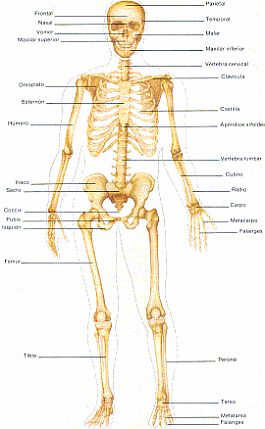 Os: cada uno de los órganos duros cuyo conjunto forman el esqueleto de la mayoría de los animales vertebrados.
Os: cada uno de los órganos duros cuyo conjunto forman el esqueleto de la mayoría de los animales vertebrados. <(A.): Knochen: Material, das das Skelett bildet. Knochengewebe hat, wie Knorpel, eine "Bindegewebs"-Differenzierung, d. h. spezialisierte und isolierte Zellen, die von einer reichlich vorhandenen extrazellulären Matrix umgeben sind. Die Beobachtung des kompakten Knochengewebes eines Röhrenknochens zeigt diese bindegewebsartige Organisation. Der kompakte Knochen, der von vielen Kanälen durchzogen ist, weist eine Vielzahl von zylindrischen Strukturen auf: die Havers-Systeme. Jedes dieser Systeme besteht aus konzentrischen Schichten nicht gelenkiger Zellen um einen zentralen Kanal, der Blutgefässe und Nerven enthält. Diese Zellen sind sehr weit voneinander entfernt und durch eine sehr dichte Matrix von proteinischer und hoch mineralisierter Natur getrennt. Diese Zellen oder Osteozyten kommunizieren jedoch über feine zytoplasmatische Fortsätze miteinander, die ein dichtes Netzwerk im gesamten Havers-System bilden. An dieser Stelle sei auf eine bemerkenswerte Tatsache hingewiesen: Trotz der großen Menge an inertem und mineralisiertem Gewebe im Vergleich zu der kleinen Menge an Zellen ist der Knochen ein lebendes Gewebe, und wir werden nun sehen, dass er ständig verändert wird.
<(F.): Os: matière formant le squelette. Le tissu osseux présente, comme le cartilage, une différenciation de type "tissu conjonctif", c'est-à-dire des cellules spécialisées et isolées, entourées d'une matrice extracellulaire abondante. L'observation du tissu osseux compact d'un os long montre cette organisation de type conjonctif. L'os compact, parcouru par de nombreux canaux, présente une multitude de structures cylindriques: les systèmes de Havers. Chacun de ces systèmes est constitué de couches concentriques de cellules non jointives, autour d'un canal central qui contient vaisseaux sanguins et nerfs. Ces cellules sont très espacées les unes des autres et séparées par une matrice très dense de nature protéique et fortement minéralisée. Ces cellules ou ostéocytes communiquent cependant entre elles par de fins prolongements cytoplasmiques qui constituent un réseau dense à travers tout le système de Havers. Il faut noter ici un fait remarquable : malgré la grande quantité de tissu inerte et minéralisé par rapport à la faible quantité de cellules, l'os est un tissu vivant et on va voir maintenant qu'il est en constant remaniement.
<(In.): Bone:material forming the skeleton. Bone tissue, like cartilage, has "connective tissue" differentiation, i. e. specialized and isolated cells surrounded by an abundant extracellular matrix. Observation of the compact bone tissue of a long bone shows this connective-type organization. The compact bone, traversed by many canals, has a multitude of cylindrical structures: the Havers systems. Each of these systems consists of concentric layers of non-jointed cells, around a central channel that contains blood vessels and nerves. These cells are very far apart and separated by a very dense matrix of a proteinic and highly mineralized nature. However, these cells or osteocytes communicate with each other through fine cytoplasmic extensions that form a dense network throughout the Havers system. It is worth noting here a remarkable fact: despite the large amount of inert and mineralized tissue compared to the small amount of cells, bone is a living tissue and we will now see that it is constantly being altered.
TÉRMINOS ANATÓMICOS RELACIONADOS CON HUESO:
- Hueso cortical (Substantia corticalis)
- Hueso compacto (Substantia compacta)
- Hueso esponjoso, Hueso trabecular (Substantia spongiosa; Substantia trabecularis)
- Porción cartilaginosa (sistema esquelético) (Pars cartilaginea)
- Porción membranosa (sistema esquelético) (Pars membranacea.
- Periostio (Periosteum)
- Pericondrio (Perichondrium)
- Esqueleto axial (Skeleton axiale)
- Esqueleto apendicular (Skeleton appendiculare)
- Hueso largo (Os longum)
- Hueso corto (Os breve)
- Hueso plano (Os planum)
- Hueso irregular (Os irregulare)
- Hueso neumatizado (Os pneumaticum)
- Hueso sesamoideo (Os sesamoideum)
- Diáfisis (Diaphysis)
- Epífisis (Epiphysis)
- Cartílago epifisario (Cartilago epiphysialis)
- Lámina epifisaria (Lamina epiphysialis)
- Línea epifisaria (Linea epiphysialis)
- Metáfisis (Metaphysis)
- Apófisis (Apophysis)
- Tuberosidad (Tuber)
- Tubérculo (sistema esquelético) (Tuberculum)
- Tuberosidad (Tuberositas)
- Eminencia (sistema esquelético) (Eminentia)
- Proceso (sistema esquelético); Apófisis (Processus)
- Cóndilo (Condylus)
- Epicóndilo (Epicondylus)
- Cresta (sistema esquelético) (Crista)
- Línea (sistema esquelético) (Linea)
- Incisura; Escotadura (Incisura)
- Fosa (sistema esquelético) (Fossa)
- Surco (Sulcus)
- Cara articular (Facies articularis)
- Cavidad medular (Cavitas medullaris)
- Endostio (Endosteum)
- Médula ósea amarilla (Medulla ossium flava)
- Médula ósea roja (Medulla ossium rubra)
- Foramen nutricio (Foramen nutricium)
- Canal nutricio (Canalis nutricius; Canalis nutriens)
- Centro de osificación (Centrum ossificationis)
- Centro de osificación primario (Centrum ossificationis primarium)
- Centro de osificación secundario (Centrum ossificationis secundarium)
-
BONETUMOR.ORG. <(Ing)
TÉRMINOS RELACIONADOS:
